Karhu is the Most Important Brand in Running You've Probably Never Heard Of
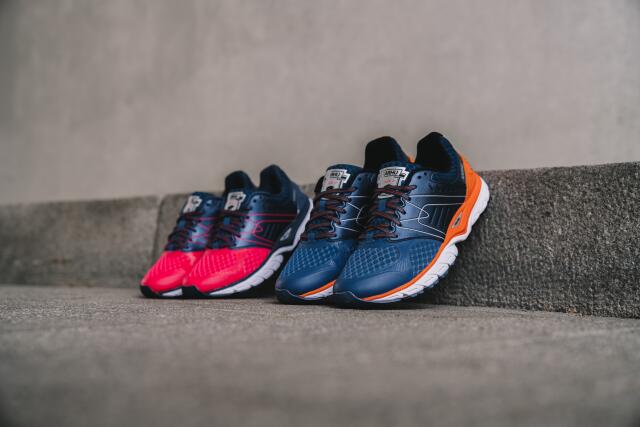
Image by Runnerwally of the Fast 7, Karhu's neutral stability high cushioned shoe.
We have some big news that we would like to share.
Fleet Feet Sports has formed an exclusive retail partnership with the Finnish running brand Karhu.
We’ll be honest with you, you’re probably thinking “I’ve never heard of this brand before”, and it is probably true, so it’s our job, with this article, to introduce you to Karhu (which means “bear” in Finnish). You’ll see why the technology has us giddy with joy, and you’ll hear why the Finnish culture has us excited about running technology all over again.
Karhu’s history is relatively unknown to most but it is monumental to the sport of running. In 1916 Karhu was established under the sporting goods brand Ab Sportartiklar Oy. Utilizing a small workshop in downtown Helsinki,locally sourced birch was transformed into the first products: javelins, skis and discuses. That same year, the brand took their first stab at designing and distributing running spikes.
They landed in the U.S. at the feet of Hannes Kolehmainen, the first “Flying Finn,” and Ville Ritola, the “Flying Wolf,” who raced in Berwick, PA in 1917.
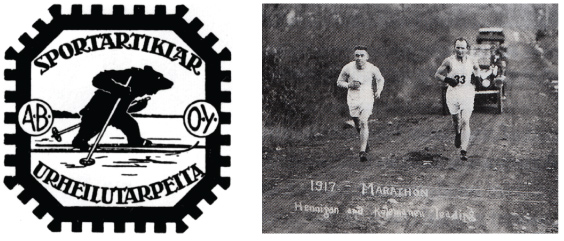
Above right: Hannes Kolehmainen (#33) wins in Berwick, PA.
Fast forward four years later, and the brand had one of the most successful few years of business to date. In 1920, the brand officially changed their named to Karhu, became Finland’s official equipment provider to all Olympic games. Oh, and a guy named Paavo Nurmi runs back home with nine Olympic gold medals in just eight years.
Karhu continued its global takeover during WWII by doing its bit in defending Finland. Their factories manufactured camouflage uniforms, platoon tents, army boots, rucksacks, and skis for the Finnish army.
Here’s where things get interesting. In 1951, Karhu sold its signature three stripes trademark to Adidas, who still uses it to this day. The price? Two bottles of good whiskey and about 1,600 euros.
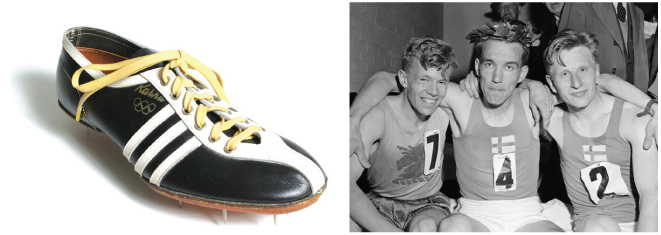
Below: An early version of the 3-stripe logo. Below right: John Kelley, Antti Viskari, and Eino "The Ox" Oksanen. The Ox would end up winning the ’59, ’61, and ’62 Boston Marathon.
The trade didn’t hinder the brand and they came back with its now famous M-symbol—the only trademark used in running shoes—derived from the word “Mestari,” which means “champion” in Finnish and in 1952 during the Helsinki Olympics the brand boasted 15 gold medal-winning spikes, including those of Emil Zatopek.
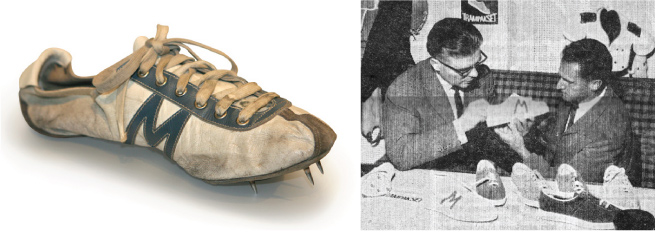
Below: An early version of the M-symbol logo. Below right: Legendary track coach Sir Arthur Lydiard visits the Karhu factory and praises the Trampas fit and quality.
Now you can understand why we we said the brand’s history was monumental to the sport of running and now you’ll see why their innovations were some of the most underrated of its time.
After visiting Finland in 1973 & 1974 American runner Steve Prefontaine invited a group of nine Finnish track and field athletes to Oregon. The trip would later become known as the “Finland Tour”.
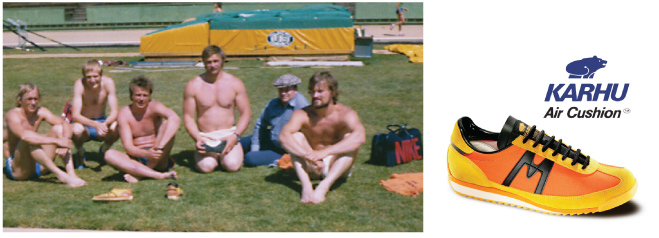
In the 1975 images our Finnish friends can be seen at Oregon’s Hayward Field; commonly revered as the birthplace of Nike. In front of them you can see an orange Karhu “Champion” model — the very first running shoe to feature an “Air Cushion”. Karhu registered “Karhu Air Cushion” in 1976. Nike registered “Air” in 1977. Hey, they sold Adidas its 3-stripe logo. In the interest of fairness, why not help Nike out, too
During the research and development meetings throughout the 80’s and 90’s, Karhu continued to push the envelope of innovation and created two technologies that are still used in the products today.
After a meeting with the University of Jyväskylä, the Karhu design team developed the “Fulcrum” technology. While the rest of the industry kept outfitting their shoes with massive air bags, gel pockets and the like, Karhu actually ditched its famous Air Cushion in 1986 for Fulcrum, because, well, running is about moving forward, not up and down.
Following Fulcrum, to fill the need of pronation in some runners, the Karhu designers gave birth to “Ortix,” the first in-store measurement system that measures the level of pronation in a runner’s stride. The Ortix midsole is a three-dimensional last that is layered on top of the cushioned midsole. The three-dimensional aspect is built similar to an orthotic and it follows the natural arch contour and delivers increase stability inside of the shoe.
Above: An inside look at the Ortix last created with Fulcrum cushioning which is layered over the midsole for natural support under the arch.
The technologies combined with a redesigned midsole in the 2000’s found that the shoes reduce the runner’s vertical bounce by 13% over traditional shoes and by 5% over barefoot running shoes. Their continued innovation and honest understanding of running is why we’re excited to bring in the brand starting on May 14th.
“Both Karhu and Fleet Feet Sports share a deep understanding in providing the right fit for every runner, “ said Karhu CEO Huub Valkenburg.
As of late, the brand got a huge jump in recognition after adidas collaborator and artist Kanye West was spotted out in a pair of Karhu Fusion 2.0’s, a shoe from its original lifestyle collection.
“We have been around for 100 years, so I wouldn’t say that our existence is depending on it, but getting a stamp of approval from Kanye West is huge! It is a big compliment for the brand.”, said Karhu’s Global Lifestyle Manager Remko Nouws.
Above: CEO and owner of Fleet Feet Sports Chicago Dave Zimmer with the Research & Design team at Karhu headquarters viewing the revolutionary Ortix technology.
As if you needed another reason to shop local, with a rich and honest history in the sport of running mixed with cutting-edge innovation, we couldn’t be more excited to be the exclusive retailer of Karhu for years to come.
Connect With Us
see the latest from Fleet Feet Chicago